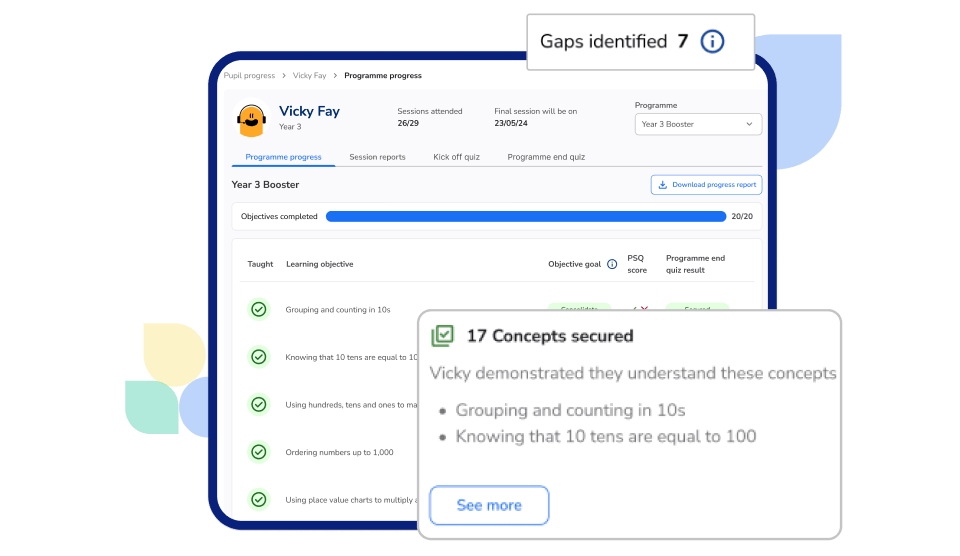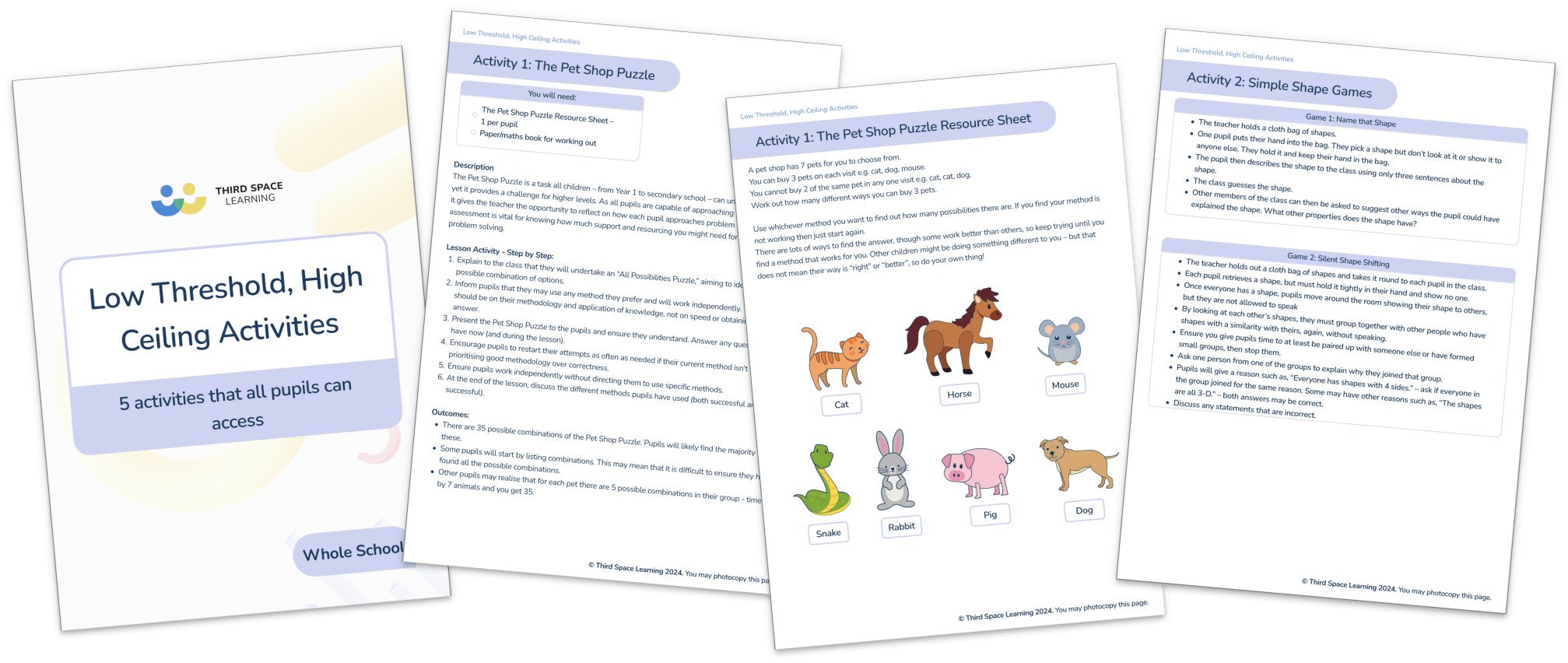Mixed Ability Teaching For Mastery: Making It Work In Your Class
Learn how to teach mixed ability maths mastery in your primary school class and how to adapt maths lessons for top set, bottom set and all ability levels.
In a typical class of Year 6 children, there is likely to be a seven-year gap between achievers in maths.
Several measures are used to manage these gaps and children may be divided into different, and apparently homogeneous ability groups or sets.
However, as more schools embrace mastery and the principles of Asian maths, whole-class teaching in maths is making a return, with a greater likelihood that teachers will be supporting or teaching children of very different abilities in maths lessons.
It’s important to address the language we use to talk about ‘ability’ and ‘attainment’. Indeed, although ‘mixed ability’ is an oft-used phrase in the educational community (and within our blogs), it can carry the assumption that learning potential is fixed. Using terms such as ‘middle attainers’ can support a more developmental mindset.
Why not just stick to setting by ability?
When children of different abilities are separated from each other, ‘top’ and ‘bottom’ can label themselves in self-fulfilling ways. Pupils are not exposed to the stimulus of discussions with others at different levels of knowledge and understanding. Teaching in sets can also mean that individual strengths and weaknesses can easily be missed.
Many teachers have a real problem with the label ‘bottom set’ or low ability students. Such powerfully derogatory and divisive terms inject failure and unambitious expectations into the minds of young learners.
It is well documented that learners’ perception of their ability is a commanding influencer on their attitude to learning. Pupils in ‘the bottom set’ find it very difficult to develop a growth mindset at primary school and that’s just wrong.
Read more: Mixed Ability Grouping in Primary Schools
Ability grouping doesn’t reflect reality
We obsess with our language for learning, but not enough when it comes to setting and grouping. All mathematicians are developing mathematicians and to clump a group of learners together as the ‘bottom’ bunch is not helpful. Mathematicians of all ages will find that they are better at some parts of the maths curriculum than others. There are only a few that are good at everything.
There is no wrong thinking in maths. Concepts are in embryo, and stages of conceptual development are not always quick to develop. It could take you years to learn how to multiply – it also might never come. The idea that you have a group of bottom, middle or top learners is flawed because there will be learning gains and natural fluid movement. All children can learn maths, but not all teachers can teach it. All children deserve access to a demanding maths curriculum.

Mixed ability maths: the research
Research shows that mixed ability maths teaching has always been more effective than setting. A study called ‘Effective classroom organisation in primary schools’ found no evidence that children learn more effectively in sets for mathematics at any level.
Critics argue that mixed ability classes can be a curse to able children as teachers spend a disproportionate amount of time helping so-called ‘weaker’ pupils. Perhaps, but the riposte is still the same: if the maths teaching is good, then all abilities will excel.

Meet Skye, the voice-based AI tutor making maths success possible for every student.
Built by teachers and maths experts, Skye uses the same pedagogy, curriculum and lesson structure as our traditional tutoring.
But, with more flexibility and a lower cost, schools can scale online maths tutoring to support every student who needs it.
Watch Skye in actionWhole-class mastery: access all areas
Teaching children maths in mixed ability groups can make some teachers anxious, especially if they’ve only ever taught one ability set. With the whole class teaching model presented by the maths mastery approach, differentiation is critical when teaching the same topic to a class with different levels of attainment.
According to the NCETM, characteristics of teaching for mastery in maths means:
- An expectation that all pupils can and will achieve.
- The large majority of pupils progress through the curriculum content at the same pace. Differentiation emphasises deep knowledge and individual support/intervention.
- Teaching is underpinned by methodical curriculum design, with units of work that focus in depth on key topics. Lessons and resources are crafted carefully to foster deep conceptual and procedural knowledge.
- Practice and consolidation play a central role. Well-designed variation builds proficiency and understanding of underlying mathematical concepts in tandem.
- Teachers use precise questioning to check conceptual and procedural knowledge. They use formative assessment throughout lessons to identify who requires intervention so that all pupils keep up.
Low Threshold High Ceiling Activities
5 printable low threshold, high ceiling maths activities for mixed ability KS2 classrooms teaching maths with a mastery approach.
Download Free Now!Differentiation strategies to try in maths
Differentiation in teaching and differentiation in the classroom should focus on how pupils can be helped to understand new concepts and techniques. Once upon a time, this meant preparing different activities or worksheets for different groups of pupils and that is still okay. Catering for the different needs of the children in your class inevitably means using various strategies and there can be advantages and disadvantages to each.
- Task/activity – different sort of tasks: visual, hands-on, auditory can all play a part in helping a learner to access the topic
- Outcome – what their end product will be, e.g. a model, a picture, written explanation
- Amount and rate of work
- Questioning
- Expectation – how far you expect children to go in an exploration/investigation and what you expect them to learn/conclude
- Resource – e.g. some may use number lines, other may use mental images
- Adult support
- Peer support – maths partners
- Role – offering children specific roles within group work, e.g. calculator, spokesperson, decision maker, recorder, tabulator, statistician, treasurer, banker
Differentiation strategies work in some situations, but not in others. It is not always possible or appropriate to differentiate by changing e.g. the range of numbers used in an activity but sometimes this is the appropriate step to take.
22 mastery techniques for your mixed ability class
There are many ways to maximise learning for all children in a mixed ability class. Including all of these features in one lesson would be unrealistic and inappropriate, but using some of them will help you design a plan for catering for different needs. The key issue is the intent behind each one and not just the act itself.
- Have high expectations of everyone
- Build on the knowledge learners already have
- Encourage reasoning rather than answer getting
- Use a rich mixture of practical apparatus, images and representations using the mastery model of concrete pictorial abstract
- Consider how much time pupils are given using concrete resources
- Use a variety of skilful questions and prompts tailored to understanding
- Milk the maths – everyone can be given the same ‘sum’ but this can be deepened in a variety of ways
- Focus on misconceptions
- Initiate maths talk, rich discussions and learning conversations
- Emphasise that there is ‘always more than one way to bake a cake’ and so it is with maths
- Listen to what children are saying and teach them to actively listen
- Encourage children to explain their thinking without loss of pace
- Insist on the precise use of mathematical terms and maths vocabulary
- Create connections between topics
- Make teaching as interactive as possible
- Demonstrate or model mathematical ideas
- Use children’s methods and working as teaching points
- Ensure that TAs are fully briefed and know how to help
- Share ideas and strategies
- Evaluate and correct children’s responses
- Reflect on what has been learnt
- Use concept cartoons
Adjusting lessons for children who struggle
According to Steve Chinn in his book, The Trouble with Maths, adjusting lessons to help pupils who are having difficulties in learning maths should be based on 4 principles:
- Empathetic classroom management – an active awareness and adjustment to the learning strengths and difficulties of pupils
- Responsive flexibility – ensuring teachers have a repertoire of resources and strategies which respond to the individual and their changing needs
- Developmental methods – methods that address the remedial need whilst developing maths skills and concepts
- Effective communication – an awareness of thinking and learning style and an awareness of limitations such as language skills, poor short-term memory or slower speeds of working
Chinn argues that the application of these principles should affect all levels of work from the construction of the syllabus and lesson plans to the setting and marking of work.
Mastering your mastery based maths curriculum
The bottom line is this: pupils are individuals and we need to teach to the individual in the group. Some pupils will respond to certain strategies better than others, but the key to helping all our children is to understand them on their own personal maths turf, and not on our soil. No intervention will work for everyone as interventions have to be engineered on a personal level.
And don’t forget to download your free Mixed Ability Maths Activity Pack!
Lots more maths resources for your primary school maths lessons are available to download from the Third Space Maths Hub. Resources include White Rose Maths lesson slides, ideas to develop maths problem solving techniques, and a maths mastery toolkit of ideas.
Registration is free and available to all school staff and parents.
DO YOU HAVE STUDENTS WHO NEED MORE SUPPORT IN MATHS?
Skye – our AI maths tutor built by teachers – gives students personalised one-to-one lessons that address learning gaps and build confidence.
Since 2013 we’ve taught over 2 million hours of maths lessons to more than 170,000 students to help them become fluent, able mathematicians.
Explore our AI maths tutoring or find out about primary maths tutoring for your school.






